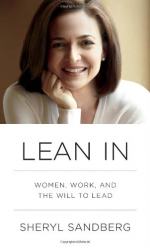
|
| Name: _________________________ | Period: ___________________ |
This test consists of 5 multiple choice questions, 5 short answer questions, and 10 short essay questions.
Multiple Choice Questions
1. Who is described as IBM’s first female CEO in Chapter 2: “Sit at the Table”?
(a) Erin Burnett.
(b) Emily White.
(c) Clara Shih.
(d) Virginia Rometty.
2. The author cites a 2012 Pew study in Chapter 1: “The Leadership Ambition Gap” which found that among young people ages 18-34, what percentage of women rated “success in a high-paying career or profession” as important to their lives?
(a) 66%.
(b) 24%.
(c) 18%.
(d) 57%.
3. Based on the 2003 study cited by the author in Chapter 3: “Success and Likeability,” she concludes that “success and likeability” are correlated how for women?
(a) Negatively.
(b) Positively.
(c) Abstractly.
(d) Demurely.
4. For how long does the author say she worked for Google in Chapter 2: “Sit at the Table”?
(a) 1 and ½ years.
(b) 6 and ½ years.
(c) 2 and ½ years.
(d) 3 and ½ years.
5. Whom does the author say started working with her “right out of college and now runs mobile partnerships for Facebook” in Chapter 5: “Are You My Mentor?”
(a) Emily White.
(b) Erin Burnett.
(c) Alice Walker.
(d) Meg Whitman.
Short Answer Questions
1. The author asserts in Chapter 3: “Success and Likeability” that what “is key to achieving more success”?
2. Who is described in Chapter 3: “Success and Likeability” as one of the engineering directors at Facebook who held a meeting in 2011 with female engineers to encourage them to share the progress they’d made on products they were building?
3. How old does the author say Mark Zuckerberg was when she graduated college in Chapter 4: “It’s a Jungle Gym, Not a Ladder”?
4. In 2010, women were paid how much for every dollar that their male counterparts were paid, according to the author in the Introduction: “Internalizing the Revolution”?
5. Where did Sheryl Sandberg attend college for her undergraduate degree?
Short Essay Questions
1. What internal report from Hewlett-Packard does the author describe in Chapter 4: "It's a Jungle Gym, Not a Ladder"?
2. How is “stereotype threat” defined in Chapter 1: “The Leadership Ambition Gap”?
3. What statistics does the author present in the Introduction: “Internalizing the Revolution” to further express her points regarding women’s equality in the workplace?
4. What was the outcome discovered in the study described in the beginning of Chapter 3: “Success and Likeability”?
5. How does Sandberg suggest one might go about soliciting a mentor in Chapter 5: “Are You My Mentor?”
6. What did Sandberg’s experience during her first pregnancy teach her about gender equality in the workplace in the Introduction: “Internalizing the Revolution”?
7. What study does the author describe in the beginning of Chapter 3: “Success and Likeability”? Who conducted the study?
8. How does the author describe Peggy McIntosh’s impressions on her in Chapter 2: “Sit at the Table”?
9. What does Sheryl Sandberg say must be overcome in order to reach true gender equality in the Introduction: “Internalizing the Revolution”?
10. Why does the author prefer to view the system of corporate advancement as a jungle gym rather than a ladder?
|
This section contains 906 words (approx. 4 pages at 300 words per page) |

|




